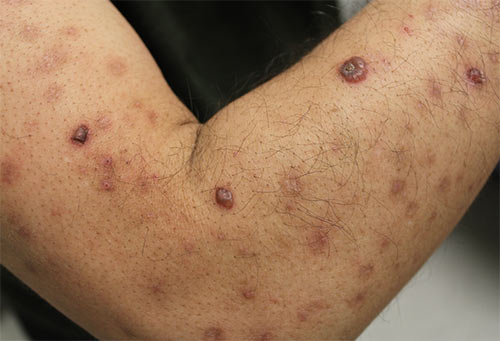June 25, 2025 | Jon Kelvey

 In March 2024, Shawn Kwatra, MD, joined the University of Maryland School of Medicine (UMSOM), where he serves as the Joseph W. Burnett Endowed Professor and Chair of Dermatology.
In March 2024, Shawn Kwatra, MD, joined the University of Maryland School of Medicine (UMSOM), where he serves as the Joseph W. Burnett Endowed Professor and Chair of Dermatology.
Dr. Kwatra is an internationally renowned dermatologist and clinical leader in skin of color research, as well as chronic inflammatory skin diseases, including atopic dermatitis, prurigo nodularis, and chronic pruritus of unknown origin. In 2024 he founded the new Maryland Itch Center at University of Maryland Medical Center, which has quickly become a destination for patients from all over the globe suffering from inflammatory skin conditions.
Under Dr. Kwatra's leadership, the UMSOM Department of Dermatology has grown rapidly, and he is working to add multiple new faculty members and expand services to multiple new clinical locations throughout Maryland.
In an edited interview, Dr. Kwatra discussed his research into inflammatory skin conditions, the growth of the Department of Dermatology, and his vision for the future of treating itch.
Q: What led to your interest in dermatology as a specialty and the study and treatment of chronic inflammatory skin diseases?
Dermatology is so much more than skin-deep. It’s the body’s largest organ — and a mirror of what’s happening inside. Every day in the clinic, we see liver and kidney dysfunction present as itching. We see psychiatric overlap in skin-picking syndromes. And we manage systemic immune diseases like atopic dermatitis and prurigo nodularis that require deep immunologic insight.
Derm is where internal medicine, psychiatry, immunology, and aesthetics all converge in one field.
But what makes dermatology truly powerful? Visibility. You can have heart failure, and no one may notice. But if you have vitiligo or severe eczema, the world sees it — and so do you, every time you look in the mirror. That’s why this specialty is about so much more than medicine. It’s about identity, empathy, and impact. That visibility makes our work not just medically important, but emotionally powerful.
Q: What are the most promising lines of research and understanding in treating chronic inflammatory skin diseases? Have any recent advances in your lab or others shifted how you understand and approach these conditions in the clinic?
 One of the most exciting frontiers in dermatology is the shift toward immunophenotyping — understanding each patient's disease at the immune system level and tailoring therapy accordingly. Our group recently obtained a patent on a novel blood test that helped us identify and publish a new skin disease called : IL-13⁺ IL-17⁺ erythroderma.
One of the most exciting frontiers in dermatology is the shift toward immunophenotyping — understanding each patient's disease at the immune system level and tailoring therapy accordingly. Our group recently obtained a patent on a novel blood test that helped us identify and publish a new skin disease called : IL-13⁺ IL-17⁺ erythroderma.
The discovery began with a single patient who came in with painful, full-body redness. Using a flow cytometry-based test, we identified that both IL-13 and IL-17 cytokines were driving the inflammation. When we targeted both, the patient dramatically improved. That’s the power of precise, targeted medicine.
This approach goes far beyond one condition — we believe it’s a model for treating all types of inflammatory skin disease, and possibly inflammatory disease more broadly. That’s why we’re now launching a major initiative: the Human Itch Mapping Project. Our goal is to immunophenotype and molecularly define every major subtype of itch, an under-recognized symptom that crosses dermatology, neurology, and immunology. We’re particularly focused on personalizing care through immune profiling — understanding not just the diagnosis, but what’s driving it at the molecular level.
On a department level, we recently launched the Center for Precision Dermatology, which is expanding this approach to conditions like hidradenitis suppurativa, keloids, autoimmune blistering diseases, and more. We're using tools like high-dimensional flow cytometry, spatial transcriptomics, and single-cell sequencing to map disease in unprecedented ways — not just to study it, but to intervene with the right therapy, to the right patient, at the right time.
Q: Shortly after joining the University of Maryland School of Medicine in early 2024, you founded the Maryland Itch Center at University of Maryland Medical Center. Could you tell us a bit about the center and its mission?
 The mission of the Maryland Itch Center is simple but ambitious: to alleviate the suffering of itch patients around the world. Itch is one of the most underrecognized yet debilitating symptoms in all of medicine, and we're working to change that.
The mission of the Maryland Itch Center is simple but ambitious: to alleviate the suffering of itch patients around the world. Itch is one of the most underrecognized yet debilitating symptoms in all of medicine, and we're working to change that.
Clinically, we’ve become a regional, national, and international destination for patients with severe itch. People are flying in from across the U.S. and even abroad. At the same time, we’re pushing forward research on multiple fronts — from intralesional occipital nerve blocks for scalp pruritus to developing ketamine infusions for neuropathic itch. I was also lead author on a New England Journal of Medicine study showing the effectiveness of IL-31 blockade with nemolizumab for prurigo nodularis.
We’re integrating basic science, translational research, and cutting-edge clinical trials, all with one goal: to offer hope and healing to patients who’ve often been told there’s nothing left to try.
Q: You’ve overseen fairly rapid growth of the Department of Dermatology since coming on board. Tell us a bit about what’s been going on there and how you managed that growth?
Academic dermatology has faced serious national headwinds when it comes to recruitment. But in just the past year, we’ve nearly quadrupled in size — and we’re still growing. This kind of rapid expansion isn’t accidental. It’s the result of having a bold, mission-driven vision and a deep commitment to supporting our people.
Our department is built around three pillars: delivering world-class dermatologic care, training tomorrow’s leaders, and advancing bold, discovery-driven science. That clarity of purpose has attracted some of the most talented faculty from around the country.
But recruiting top talent is only part of the story. We also give our faculty the freedom to practice medicine with flexible schedules, robust staffing, and a culture designed to promote renewal, creativity, and impact. We’re not just aiming to avoid burnout — we’re hoping to lead a generational shift in academic dermatology.
At the same time, we’re expanding access to care. We’ve opened two state-of-the-art clinical sites in Lutherville and Columbia. Lutherville may be the most advanced academic medicine ambulatory facility built to date. And our Columbia site will host what we believe is the world’s first dedicated oculocutaneous disease clinic, led by Dr. Aisha Mumtaz, bridging dermatology and ophthalmology for patients with complex skin-eye disorders.
And this is just the beginning. We’re committed to forging a new path to building the future of dermatologic care for Maryland, the Mid-Atlantic, and for academic medicine nationwide.
Q: Dermatology, both your department and the field, are going through a lot of changes at the moment. What’s your vision for the future?
The only constant in health care is change, and in dermatology, that change is accelerating. At Maryland, we’ve made a deliberate decision to lead that evolution. Integrating flexibility, operational efficiency, and transparency into the academic model has enabled us to grow rapidly, recruit top-tier talent, and better serve our community, all while staying true to our mission to deliver excellent regional care.
What makes this moment so powerful is the alignment of discovery, clinical impact, and institutional leadership. With the support of Dean Mark Gladwin, Dr. Bill Regine, President of University of Maryland Faculty Physicians, and Dr. Bert O’Malley, President and CEO of the University of Maryland Medical Center, we’re building an environment where innovation can thrive—anchored in purpose, transparency, and momentum.
Our vision is bold: not just to lead academic dermatology nationally, but to become a global beacon for advancing the science, care, and culture of skin health.”
Watch the Video:
Contact
Office of Public Affairs
655 West Baltimore Street
Bressler Research Building 14-002
Baltimore, Maryland 21201-1559
Contact Media Relations
(410) 706-5260
